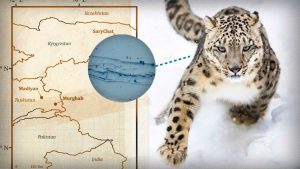UD research examines food habits of snow leopards
In order to create effective conservation programs to help protect and conserve populations of endangered snow leopards, whose estimated population is between 4,500-7,500 in the wild, University of Delaware researchers are studying their scat to try and understand what the large cats are eating.
While studying snow leopard scat is one of the least invasive ways to look at what the animals are eating and gauge their food preferences, according to a new UD study it may not always be the most accurate. Researchers found that past food-habit studies on snow leopards could have been biased by the inclusion of non-target species in fecal analysis, potentially misinforming managers about the prey requirements that allow snow leopard populations to succeed.
The research was led by Sarah Weiskopf, who recently received her master’s degree from the College of Agriculture and Natural Resources and who did the work as part of her undergraduate senior thesis; Kyle McCarthy, assistant professor of wildlife ecology; and Shannon Kachel, a graduate student who works with McCarthy. The findings were published in the Wildlife Society Bulletin.
Large ungulates
As a result of non-target species possibly being included in past research studies, it has been thought that snow leopards — who lack an abundance of natural prey — consume great numbers of small mammals such as marmots, hares and pika, as well as wild ungulates, which are larger hooved animals such as ibex.
While estimates of the amount of small mammals snow leopards consume may have been overstated, the importance of large ungulate populations to the snow leopard’s diets may have been understated, as this study suggests stable snow leopard populations are possibly more reliant upon large ungulate prey than previously understood.
“We’ve got this concept of what snow leopard scat looks like and where it can be found, so we think we can go out and collect it. A lot of old studies on what snow leopards eat are based on just that, collections that people have done in the wild,” said McCarthy. “When we started doing genetics on snow leopard feces to try and get at a different question, which was individual identification of snow leopards, we started realizing that a lot of what we picked up and thought was snow leopard scat was not.”
Weiskopf explained that a big problem with collecting and identifying scat in the field is that researchers mostly rely on morphological characteristics such as shape, size or associated signs of snow leopards, and since scat from different species can look similar, this can lead to misrepresented population estimates and errors in reporting what the snow leopards are actually eating.
“This can affect conservation plans because if snow leopards are eating more large ungulates, we need to make sure we’re maintaining those large ungulate populations. Otherwise, a population of snow leopards might not survive because there’s not enough prey, or they may start eating more domestic livestock, which can cause problems with local human populations. That could result in people going out and killing snow leopards in retribution,” said Weiskopf.
Field versus genetic analysis
The researchers wanted to look at the problem in a blind fashion, comparing their data sets of what they believed to be snow leopards and what those supposed snow leopards ate with a data set of snow leopard scat that was confirmed through genetic analysis to be from actual snow leopards.
“That’s what we consider the bias in our food habit studies and that was the ultimate goal of Sarah’s project — to find out how far off we may have been in the past with what snow leopards eat and then ultimately refining our understanding of what they eat,” said McCarthy.
The researchers analyzed 199 suspected snow leopard scat samples collected from two study sites in Tajikistan during the summer of 2012 and 56 scats collected from two study sites in Kyrgyzstan between June and December of 2005.
Overall, only 36.1 percent of collected scats thought to be from snow leopards were confirmed as snow leopard. The snow leopard samples were most often confused with red fox scat, which comprised 39.6 percent of collected samples.
“We don’t want to overstate our results because this was just one study, but we did notice that if we were using the blind approach, we definitely had a lot more small mammal occurrence in those scats. When we used genetics to pre-screen the scat and find out which ones were actually snow leopard, there were many fewer small mammals in those scats,” said McCarthy, who added that many of the small mammals consumed in the original blind data set were much more associated with red fox.
“It’s a little bit of conjecture, but our thought is that a lot of food habit studies that have not been able to verify that their scat is actually from the species that they’re studying probably do have this bias soaking in from other species,” said McCarthy.
Prey identification
To determine what the snow leopards were actually eating, the researchers pulled hairs found in the samples and studied them on slides treated with nail polish.
“We looked at the whole hair under the microscope to see the medulla, which is the inner part of the hair. Then we pulled the hair off to look at the impression that was left in the nail polish to see the pattern on the outer part of the hair,” said Weiskopf.
All hairs have a different scale pattern on them and the researchers could tell the individual species based on the scale pattern or the characteristics of the medulla.
The research was funded by a National Science Foundation Experimental Program to Stimulate Competative Research (EPSCoR) grant and the state of Delaware as well as the International Snow Leopard Trust, Kumtor Operating Company, Panthera Foundation and the Wildlife Conservation Society.
Check out additional media concerning UD’s snow leopard research on UD’s Tumblr.
– Article by Adam Thomas
*Source: University of Delaware

